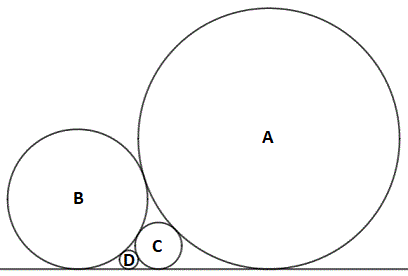More Kissing Circles
Circles A , B , C , and D are all tangent to the same line, circle A is also tangent to circles B and C , circle B is also tangent to circles C and D , circle C is also tangent to circle D , and A > B > C > D .

If the radius of B is 7 2 and the distance between the centers of A and D is 1 1 2 0 , find the radius of circle C .
The answer is 45.
This section requires Javascript.
You are seeing this because something didn't load right. We suggest you, (a) try
refreshing the page, (b) enabling javascript if it is disabled on your browser and,
finally, (c)
loading the
non-javascript version of this page
. We're sorry about the hassle.
2 solutions
neat elucidation Sir, cheers!
Log in to reply
though I have a disagreement with the "sangaku problem" ;)
( x d − x c ) 2 + ( r d − r c ) 2 = ( r d + r c ) 2 ( x a − x c ) 2 + ( r a − r c ) 2 = ( r a + r c ) 2 ( x a − x b ) 2 + ( r a − 7 2 ) 2 = ( r a + 7 2 ) 2 ( x d − x a ) 2 + ( r d − r a ) 2 = 1 1 2 0 2 x d 2 + ( 7 2 − r d ) 2 = ( 7 2 + r d ) 2 x c 2 + ( 7 2 − r c ) 2 = ( 7 2 + r c ) 2 x b = 0
And Wolframalpha use for this system wolframalpha , we see r c = 4 5 .
If the radius of B is R and the radius of C is r , then Descartes' Theorem tells us that the radii of A and D are r A = ( R − r ) 2 R r r D = ( R + r ) 2 R r respectively. The horizontal distance between the centres of A and D is therefore 2 R r A − 2 R r D = R − r 4 R r while the vertical distance between the centres of A and D is r A − r D = ( R − r ) 2 4 R r R r If L is the distance between the centres of A and D, we obtain the equation L 2 = ( R − r ) 2 1 6 R 2 r 2 + ( R − r ) 4 1 6 R 3 r 3 = ( R − r ) 4 1 6 R 2 r 2 ( r 2 − r R + R 2 ) In this case R = 7 2 and L = 1 1 2 0 , and we obtain the quartic equation ( r − 4 5 ) ( 1 4 3 r 3 − 3 6 9 3 6 r 2 + 3 0 4 8 1 9 2 r − 9 1 4 4 5 7 6 0 ) = 0 The only real zero of the cubic term is 1 3 6 . 3 7 . . . , and so (since we definitely have r < 7 2 ), we deduce that r = 4 5 .